Brooklyn Artisan’s 12 Days of Brooklyn is our gift of the season when you visit our site.
12 Views of Brooklyn were gathered from artists and photographers who have looked at Brooklyn through creative and loving eyes and curated by Anne Mollegen Smith. 12 Tastes of Brooklyn were sampled and curated by Basia Hellwig. 12 Sips of Brooklyn were sampled and curated by Bruce A. Campbell.
Typographic designs of the date stamps for all 12 days are by Joy Makon Design.
DEC. 6 Date stamp font: Avant Garde, by Herb Lubalin and Tom Carnese, ITC, 1970.
The arch at Grand Army Plaza decorated for the holidays, photograph by Joseph Caserto. A resident of Brooklyn since the late 1980s, Caserto is an award-winning publication designer and earned a BFA with honors from Pratt Institute. See more of his work at etsy.com/shop/josephcaserto
EDITOR’S UPDATE: Joseph Caserto has kindly offered Brooklyn-Artisan visitors a 30% discount on boxed card sets that include this brilliant image of Grand Army Plaza on a winter night. Go to http://www.etsy.com/shop/josephcaserto and use the coupon code COUNTDOWN12.
DEC. 7 Date stamp font: Mrs Eaves, by Zuzana Licko, Emigre, 1996
Brooklyn Botanic Garden, photograph by Jake Miller. Miller is a writer as well as a photographer and was a Brooklyn resident in the 1990s, when he shot a series called Brooklyn Light. His articles and photographs have appeared in many national magazines. He now lives in the Boston area.
DEC. 8 Date stamp font: Bauhaus, by Ed Benguiat and Victor Caruso, ITC, 1975
Menorah in the Snow, photograph by Joy Makon, taken in 2009 in Windsor Terrace. A resident of small-town Brooklyn since 1983, Joy is a magazine art director+designer and an indefatigable lover of all things new and cool. She curates Craft & Design for Brooklyn Artisan and writes and produces the weekly Best of Brooklyn listings.
Dec. 9 Date Stamp font: Cochin, Georges Peignot, Linotype, 1912
 Sledding Home, 2009, is an oil-on-canvas painting by Ella Yang, who is a member of the artist-run collective and gallery, 440 Gallery, in Park Slope. The gallery is run collectively by more than a dozen artists with very different styles and outlooks, but a common commitment. It is located in Park Slope on Sixth Avenue between Ninth and Tenth streets.
Sledding Home, 2009, is an oil-on-canvas painting by Ella Yang, who is a member of the artist-run collective and gallery, 440 Gallery, in Park Slope. The gallery is run collectively by more than a dozen artists with very different styles and outlooks, but a common commitment. It is located in Park Slope on Sixth Avenue between Ninth and Tenth streets.
Dec. 10 Date stamp font: Chalet Tokyo, by René Albert Chalet (a clothing designer), House Industries, 1970
 At right, these 4 panels appear to the right of the children’s
At right, these 4 panels appear to the right of the children’s 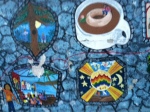 panel in the 8th Street mural. Just down the street is a Beansprouts childcare center, and around the corner, a church.
panel in the 8th Street mural. Just down the street is a Beansprouts childcare center, and around the corner, a church.
·
‘
Dec. 11 Date stamp font: Goudy Oldstyle, by Frederick W. Goudy, Linotype, 1915
When you visit the site of the Mill Basin house, you can sign the guestbook and review the extensive press clippings. 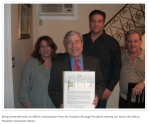 At right, Brooklyn Borough President Marty Markowitz, holding the proclamation, with the Teitelbaum family.
At right, Brooklyn Borough President Marty Markowitz, holding the proclamation, with the Teitelbaum family.
Dec. 12 Date stamp font: Gill Sans Ultra Bold, by Eric Gill, Monotype, 1928
 September Rain, Seventh Avenue, 2006, etching by Eric March (edition of 25). Eric March’s first solo show was A Brooklyn Year at the Park Slope Gallery in 2006. His second show at the gallery was Moments in Time: Queens to Coney Island, in 2009. He teaches painting and illustration in the New York City area. The Park Slope Gallery shows by appointment.
September Rain, Seventh Avenue, 2006, etching by Eric March (edition of 25). Eric March’s first solo show was A Brooklyn Year at the Park Slope Gallery in 2006. His second show at the gallery was Moments in Time: Queens to Coney Island, in 2009. He teaches painting and illustration in the New York City area. The Park Slope Gallery shows by appointment.
Editor’s Note: Making and printing etchings are special skills: Etching is generally done to a metal plate by coating the surface, then scratching through the coating with a special stylus; an acid is then used to eat away the scratched lines which later hold the ink for the image to be printed. A particular piece is usually identified by the position in the series and the number that are in the edition – 1/25 meaning the first of 25, and so on. A lower number is not necessarily an indicator of quality, since much effort goes into making all the pulls equally good; rather, it is a way of tracking or inventorying the images to discourage theft, loss and forgery, and signals relative scarcity. The artist’s signature – usually written in pencil – shows that he approved the quality of that particular piece. A gallery or publisher sometimes underwrites a limited edition as a form of investment, and value may even rise as inventory shrinks.
Dec. 13 Date stamp font: Shelley Allegro, by Matthew Carter, Linotype, 1972
Porches in the Snow, 2009, by Joy Makon. See her bio above, for Dec. 8. For most of her publications career, Joy has worked as a designer, but as readers of her Joy’s Best of Brooklyn column for Brooklyn Artisan know, she also writes well. Early sign of crossover skills: She was editor of her high school newspaper, and went from there to art school.
Dec. 14 Date stamp font: Rockwell, by Morris Fuller Benton and Frank Pierpont, Monotype, 1934
Canal Cloud Reflections, 2010, another oil painting by Ella Yang (see Dec.9, above).”This was a very still morning, the water in the Gowanus Canal was high and there were plenty of clouds to make great reflections,” she recalls. “I love the contrast between the dilapidated, jumbled items on the left bank and the apparent organization of the buildings on the right bank. That’s the former Williamsburg Bank building on the right – a nice Brooklyn landmark that’s been turned into luxury condos!” Ella is a member of the art collective, 440 Gallery. (Next time you’re on the 440 Gallery site, browse the work of other gallery artists. You can also find other views of the Gowanus, this time abstracts, by 440’s Karen Gibbons.)
Dec. 15 Date stamp font: American Typewriter, by Joel Kaden and Tony Stan, ITC, 1974
The Brooklyn Roasting Co. maintains a phog – a photographic blog – on its site and invites contributions from outside the company. The result is a delightful mélange of coffee growing photographs, of the company’s staff and friends, of DUMBO and elsewhere in Brooklyn. This couldn’t-be-anywhere-but-DUMBO image emerged from that phog. Notice how the image is a study in verticals, from the construction fence through the tall alley and bridge struts to the towers of Outer Brooklyn across the river.
Dec. 17: Date stamp font: Industria, by Neville Brody, Linotype, 1989
Christmas Trees on Sale: Brooklyn-based design professional Joseph Caserto, whose Grand Army Plaza photo launched our series, also contributed this image of a Christmas tree vendor. Joe tweets – @josephcaserto – about his @udemy courses for students to learn InDesign, Adobe PhotoShop, Adobe Digital Publishing Suite, sometimes at a discount. He also sells his work at etsy.com/shop/josephcaserto, with occasional discounts.
In 1851, the same year Henry Gritten (mentioned in Dec.14: 12 Views of Brooklyn) painted Gowanus Bay, a Catskill Mountains farmer named Mark Carr launched the commercial Christmas tree business in New York City with two ox-drawn sleds loaded with forest-cut trees. He sold them all, and harvesting forest trees became a business, a kind of winter crop. In 1901, a from-scratch Christmas-tree farming operation was established in New Jersey, and seven years later their Norway Spruces went on the market for $1.00 apiece. By 2000, the number of American families using artificial trees was significantly larger than those with natural ones.
Dec. 17 Date stamp font: Mason, by Jonathan Barnbrook, Emigre, 1992
Forget those people trying to sell the Brooklyn Bridge to hayseeds, how does one go about finding a large photograph of it suitable for framing? The selection is mind-boggling. You can check museum shops. You can inquire of Brooklyn photographers whose work you like. You can search by subject on many sites such as etsy.com and fineartamerica.com. There’s instagram and pinterest and the Flickr albums of your friends; ask around. Cross the river and check out the Union Square vendors. You can of course go out yourself, camera or iPhone in hand, by night and by day. You can order prints by size and by medium – would you like a print on canvas? Or in acrylic? Or acrylic on glass? Oh, you’ve settled on having the canvas wrapped around the sides of the mounting? You can get that done at the drug store right on the corner of Flatbush and Seventh Avenue. Step number one in a personal Views of Brooklyn gallery.
The portrait of Emily Warren Roebling in the Brooklyn Museum is by the French painter Charles Émile Auguste Carolus Duran. Emily’s older brother, Civil War General Gouveneur Kemble Warren –and the one who supported her interest in becoming educated though a girl – is remembered by his statue at the gateway to Prospect Park. Although the Warren family came from Cold Spring, NY, not Brooklyn, the brother and sister made their mark on this community.
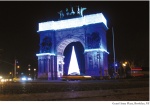


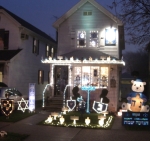

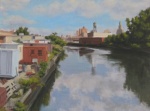

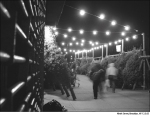



















[…] The Soldiers’ and Sailor’s Arch at Grand Army Plaza lighted for the holidays: Built in 1892 to mark the entrance to Prospect Park, it was modified three years later when bronze statuary was added. Originally Prospect Park Plaza, it was renamed Grand Army Plaza in 1926 as commemoration for veterans of the Union Army in the Civil War. In 1975, it was designated a National Historic Landmark. Photograph by Joseph Caserto; for more, see our Who’s Who. […]
LikeLike